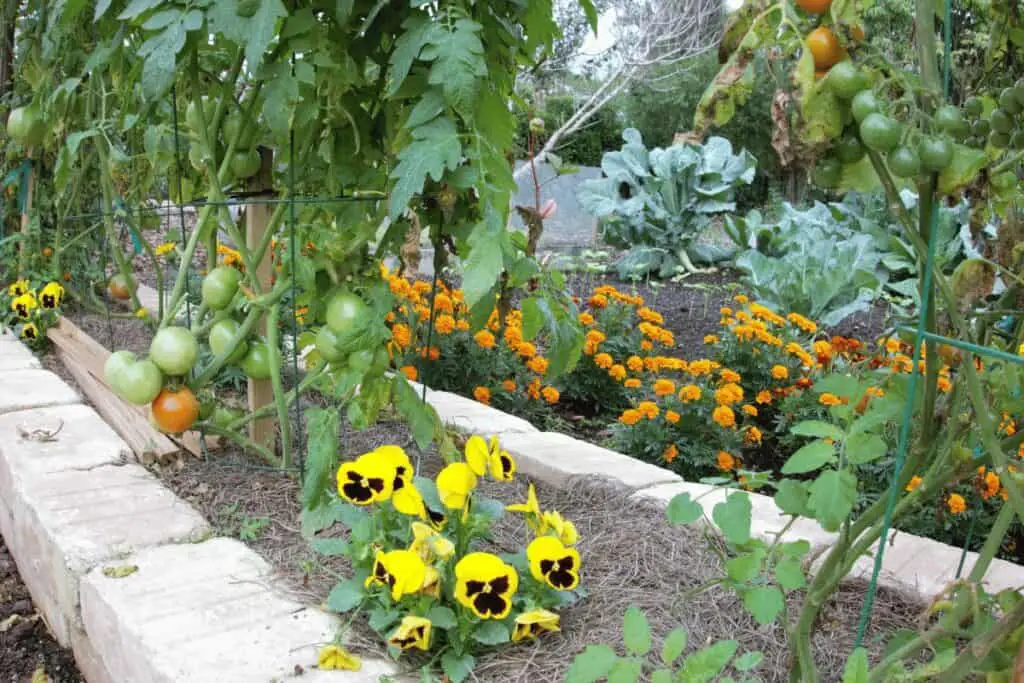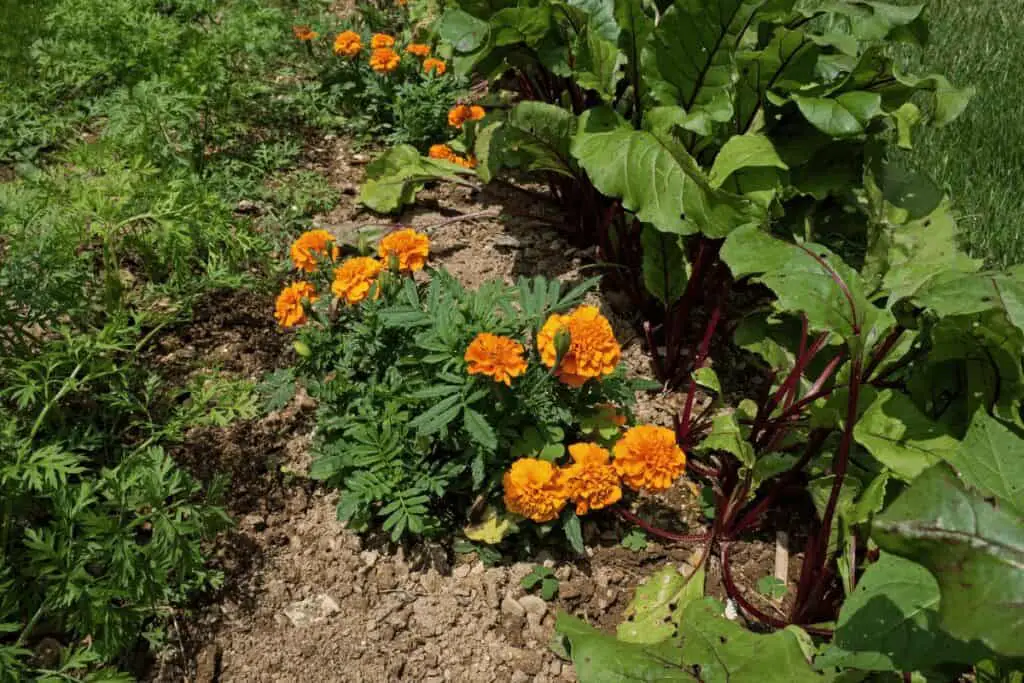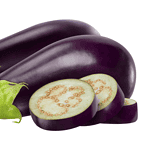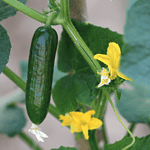Companion planting is a gardening technique that involves planting different types of plants in close proximity to each other in order to achieve specific benefits. Companion planting is not only a great way to improve the health and productivity of your herb garden, but it also has a number of other benefits that can make it a valuable addition to any home garden. In this article, we will explore the benefits of companion planting in your herb garden and provide you with some tips and ideas for getting started.
This is an amazing infographic check out

Improved Pest Control
One of The Primary Benefits of Companion Planting in Your Herb Garden Is Improved Pest Control. by Planting Certain Herbs Alongside Other Plants, You Can Help to Repel Harmful Insects and Diseases that Can Damage or Destroy Your Crops. for Example, Basil Is a Natural Pest Repellent and Can Be Planted Alongside Tomatoes to Help Protect Them from Pests. Similarly, Chives and Garlic Can Be Used to Repel Aphids and Other Harmful Insects, While Mint Can Help to Deter Slugs and Snails.
Improved Pollination
Another Benefit of Companion Planting in Your Herb Garden Is Improved Pollination. by Planting a Diverse Range of Plants in Close Proximity to One Another, You Can Encourage the Presence of Pollinators Such as Bees and Butterflies, Which Are Vital for The Reproduction of Many Plants. This Is Especially Important for Herbs Like Basil, Dill, and Cilantro, Which Rely on Pollinators for Seed Production.
Enhanced Soil Quality
In Addition to Providing Pest Control and Pollination Benefits, Companion Planting Can Also Help to Enhance the Quality of Your Soil. Certain Herbs, Such as Clover and Legumes, Are Known for Their Ability to Fix Nitrogen in The Soil, Which Can Help to Improve Soil Fertility and Structure. Other Herbs, Such as Comfrey and Nettles, Are High in Nutrients and Can Be Used as Natural Fertilizers to Help Feed and Nourish Your Plants.
Increased Productivity
Companion Planting Can Also Help to Increase the Productivity of Your Herb Garden. by Planting Complementary Plants Alongside One Another, You Can Create a More Diverse and Balanced Ecosystem that Is Better Able to Support the Growth and Development of Your Crops. for Example, Planting Basil Alongside Tomatoes Can Help to Improve the Flavor and Yield of Both Plants. Similarly, Planting Chamomile Alongside Onions Can Help to Improve the Health and Vigor of Both Crops.

Improve Companion Planting Combinations
There Are Many Different Combinations of Herbs that Can Be Used in Companion Planting to Achieve Specific Benefits. Some of The Most Effective Combinations Include:
Basil

Caribou Seed Company
Organic Genovese Basil (herb) – Pesto, Salad, Pizza – 100+ Seeds, Fresh Canadian Seed
Tomatoes

Tasty Tomatoes by Caribou Seed Company
4 Different Tomatoes | Beefsteak, Cherry, Brandywine, Roma Plum | Tomato Seed Kit | Organic, Gmo-Free/canadian
- Basil and Tomatoes: basil Is a Natural Pest Repellent and Can Help to Improve the Flavor and Yield of Tomatoes when Planted Alongside Them.
- Chives and Carrots: Chives Can Help to Repel Carrot Flies and Other Pests, Making Them a Valuable Companion Plant for Carrots.
- Dill and Cucumbers: Dill Can Help to Improve the Flavor and Yield of Cucumbers when Planted Alongside Them.
Improved Aesthetics
In Addition to The Practical Benefits of Companion Planting, It Can Also Help to Improve the Aesthetics of Your Herb Garden. by Planting a Diverse Range of Herbs Alongside One Another, You Can Create a Visually Appealing and Harmonious Garden that Is a Pleasure to Be In.
Greater Diversity
Another Benefit of Companion Planting Is the Increased Diversity It Brings to Your Herb Garden. by Planting a Variety Of Herbs Alongside One Another, You Can Create a More Diverse and Balanced Ecosystem that Is Better Able to Support the Growth and Development of Your Crops.
Improved Space Utilization
Another Benefit of Companion Planting Is Improved Space Utilization in Your Herb Garden. by Planting Different Herbs Alongside One Another, You Can Make Better Use of The Available Space and Create a More Efficient and Productive Garden. for Example, You Can Plant Taller Herbs Such as Rosemary and Thyme Alongside Shorter Herbs Such as Chives and Parsley, Allowing You to Make the Most of The Vertical Space in Your Garden.
Rosemary

Caribou Seed Company
Organic Rosemary | 100 Seeds | Meats, Sauces | Fresh Seed & High Germination | Canadian Herb Seed
Chives

Caribou Seed Company
Organic Garlic Chives – 100+ Seeds – Fresh, Easy to Grow, Canadian Herb Seed
Enhanced Flavor and Aroma
In Addition to The Practical Benefits of Companion Planting, It Can Also Help to Enhance the Flavor and Aroma of Your Herbs. by Planting Complementary Herbs Alongside One Another, You Can Create a More Diverse and Complex Flavor Profile that Is More Pleasing to The Senses. for Example, You Can Plant Basil Alongside Tomatoes to Enhance Their Flavor, or Plant Chamomile Alongside Onions to Create a More Aromatic and Flavorful Combination.
Increased Resilience
Finally, Companion Planting Can Help to Increase the Resilience of Your Herb Garden by Creating a More Diverse and Balanced Ecosystem. by Planting a Variety of Herbs Alongside One Another, You Can Create a Garden that Is Better Able to Withstand Stresses Such as Pests, Diseases, and Extreme Weather Conditions. This Can Help to Ensure the Long-Term Health and Productivity of Your Herb Garden, and Make It More Resistant to The Challenges of Gardening.

Additional Information from Other Resources
Https://i.Redd.It/4wyqd5n9nh281.Jpg
Https://en.Wikipedia.Org/wiki/medicinal_Plants
Https://en.Wikipedia.Org/wiki/herb
Conclusion
In Conclusion, Companion Planting Is a Valuable Gardening Technique that Can Provide a Wide Range of Benefits for Your Herb Garden. from Improved Pest Control and Pollination, to Enhanced Soil Quality and Increased Productivity, There Are Many Reasons to Consider Incorporating Companion Planting Into Your Garden. Whether You Are an Experienced Gardener or Just Starting Out, Companion Planting Is a Simple and Effective Way to Improve the Health and Beauty of Your Herb Garden.
FAQ
What Is Companion Planting?
Companion Planting Is a Gardening Technique that Involves Planting Different Types of Plants in Close Proximity to Each Other in Order to Achieve Specific Benefits. Companion Planting Can Help to Improve Pest Control, Pollination, Soil Quality, and The Productivity of Your Herb Garden.
What Are Some Common Herbs Used in Companion Planting?
Some Common Herbs Used in Companion Planting Include Basil, Chives, Dill, Garlic, Mint, and Clover. These Herbs Can Help to Repel Pests, Improve Soil Quality, and Enhance the Flavor and Aroma of Other Herbs when Planted Alongside Them.
What Are Some Examples of Effective Companion Planting Combinations?
Some Effective Companion Planting Combinations Include Basil and Tomatoes, Chives and Carrots, and Dill and Cucumbers. These Combinations Can Help to Improve the Health and Productivity of Both Plants when Planted Alongside One Another.
How Do I Get Started with Companion Planting in My Herb Garden?
To Get Started with Companion Planting in Your Herb Garden, You Should First Research the Specific Benefits and Requirements of The Herbs You Want to Plant. You Should Then Plan out Your Garden Layout, Keeping in Mind the Specific Companion Planting Combinations You Want to Use. Finally, You Should Plant Your Herbs According to Your Plan, Taking Care to Follow Proper Planting and Care Instructions for Each Individual Herb.
Can I Use Companion Planting with Other Types of Plants Besides Herbs?
Yes, Companion Planting Can Be Used with A Wide Variety of Plants, Not Just Herbs. in Fact, Many of The Principles of Companion Planting Are Applicable to Any Type of Home Garden, Whether It Is a Vegetable Garden, Flower Garden, or A Combination of Different Types of Plants.
Latest Post
- How to Plant Mushroom Seeds for Maximum Germination

- How to Plant Lettuce Seeds for Maximum Germination

- How to Plant Kale Seeds: A Step-by-Step Guide to Maximum Germination Success!

- How to Plant Eggplant Seeds: A Step-by-Step Guide to Maximum Germination Success!

- How to Plant Cucumber Seeds for Maximum Germination

- How to Plant Chili Pepper Seeds for Maximum Germination





